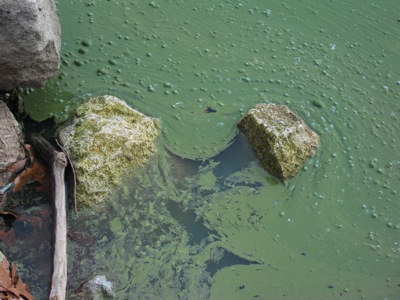Wednesday, November 21st, 2012
Toxin level remains high
Scum on Grand Lake shoreline makes unusual appearance
By Nancy Allen

Photo by Nancy Allen/The Daily Standard
Algae scum surrounds a rock in Grand Lake off West Bank Road on Tuesday. Warm, sunny weather, calm water and excess nutrients contributed to the late bloom that covered much of the Celina shoreline earlier this week. Most of the scum was gone this morning.
GRAND LAKE - The lake doesn't look good.
Blue-green algae toxin levels recorded in recent weeks were the highest they've been all year, and much of the Celina shoreline was coated with slimy growth on Tuesday.
Ohio EPA spokeswoman Dina Pierce said toxin levels may have doubled in October due to algae dying off as temperatures dropped.
"Blue-green algae tends to produce and release toxins as it dies off," she said. "Cooler weather causing a mass die-off can lead to higher toxin levels."
The highest algae toxin reading this year of 83.2 parts per billion was recorded in mid-October. Typically, the worst months for blooms are August and September, when temperatures are hot and humid. The high readings in August and September were 50 ppb and 40.2 ppb, respectively. Monthly toxin averages this year were double or more compared to 2011.
Why is the algae blooming in November? It's likely the weather.
"It goes back to the conditions being right," Pierce said. "Nutrients, plus warm temperatures, plus sunshine and calmer waters where it's not getting stirred up allows for better growing conditions, and that can happen anytime of the year."
Brian Miller, manager at Grand Lake St. Mary State Park, said he can't remember a bloom this large so late in the season.
"One thing that's been uncommon the last four days is it's been very calm," Miller said of the lack of wind and wave action on the lake.
Miller also noted recent warm temperatures may be letting the blooms hang on past what is typical. Temperatures have been near 60, about 10 degrees higher than normal for this time of year.
The city's treated drinking water continues to test negative for toxins, Celina Water Treatment Plant Superintendent Mike Sudman said. The lake is the city's sole source of drinking water.
The current bloom is likely planktothrix, the lake's dominant blue-green algae for years, except in 2010 when the multi-colored aphanizomenon coated the lake in thick mats.
Blue-green algae, also called cyanobacteria, is common in many water bodies and can grow thick in waters with lots of phosphorous from manure, commercial fertilizers and sewage that rains wash into streams. The algae produces liver and nerve toxins that can sicken people and kill small animals.
There is an overabundance of phosphorous in Grand Lake's water and in the sediment that's been accumulating in the lake bottom for decades. Most of the phosphorous that enters the lake runs off farmland, the largest land use in the 58,000-acre watershed. Phosphorous-fed toxic blue-green algae blooms have resulted in advisories and millions in lost tourism on the 13,500-acre lake the last four summers.
Other weather conditions that worked against the lake include this summer's drought and this fall's heavy rains, officials say.
The drought concentrated nutrients in the lake, biology professor Robert Hiskey said, while the rains likely washed in more phosphorous, Pierce added.
Rainfall in October totaled almost five inches, more than double the 20-year average for that month, local weather forecaster Dennis Howick said.
Also, a lot of nutrients normally used by growing crops did not get taken up by the plants this year due to the drought, which increases the potential for phosphorous runoff, OSU Extension official Jim Hoorman said. Rain is needed to work nutrients into the soil so crops can use them.
The more nutrients there are to feed algae, the greater the likelihood for algae blooms and toxins.
The state in 2011 and this year spent a combined $8.4 million to treat the 4,900-acre center of the lake with alum in an attempt to curtail algae blooms. Alum deactivates phosphorous, algae's favorite food.
The treatments have been incremental in nature and not the full dose necessary to optimally treat the lake. The state considered the cost ($30 million) to optimally treat the lake prohibitive. To date, the lake has received 25 percent of the alum it needs to receive optimal treatment, the state's consultant on the project says.
The state said it will not make a decision on whether it will pay for a third alum treatment next year until it receives a report on the effectiveness of this year's treatment. The report is due the end of this year. The 2011 alum treatment reduced phosphorous levels by up to 56 percent in the lake's center and 20 to 30 percent in untreated areas.
Miller said despite the lake's current condition, tests show the alum is tying up phosphorous.
"All along it was a phased-in approach because of funding," he said. "We have tied up phosphorous, and that's what it's all about."
Average algae toxin levels:
(parts per billion)
2011 2012
Jan. .33 .55
Feb. .45 1.1
March .52 27.1
April .9 46.2
May 13.7 32.7
June 15 31.5
July 5.5 37.4
Aug. 4.5 37
Sept. 22.4 44.7
Oct. 26.6 57.1
Source: Ohio EPA



